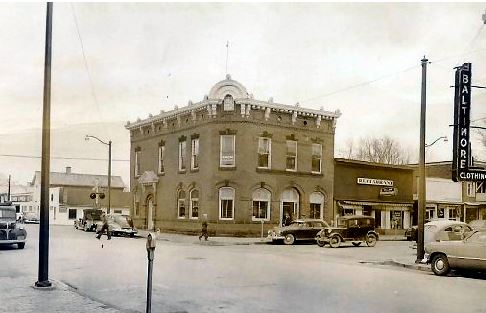History of the Newcomerstown Public Library
The Newcomerstown Public Library was officially organized as a school district public library in February of 1935. A year earlier, the Heller Brothers Tool Company and The Women’s Club arranged for a rotating collection of 300 books from the New Philadelphia Public Library to loan to factory workers. In June of 1934, the Newcomerstown School Board passed a resolution asking for funds to establish a public library in Newcomerstown. Area residents responded generously in spite of post-depression hardships. Contributions came from individuals, local industry, merchants, lodges, civic groups and social organizations. Two tag days and a movie sponsored at the Ritz Theatre also contributed to the library fund.
June 1, 1935, the Newcomerstown Public Library opened its doors in a donated room on the second floor of the J. M. Kaden Building at 119 ½ Main Street. Furniture and shelving were built by local carpenter and founding trustee, Warren Prosser, with help from the members of Heller’s Foremen’s club volunteering their time. Two thousand books graced the new shelves by opening day. Most of the books were donated by area residents and the public libraries in Dover and New Philadelphia. Three hundred books were on loan from the State Library of Ohio. By October 1938, the Library had outgrown the space, and moved to the second floor of the Ortt building at 143 ½ Main Street over the A&P grocery store. The collection continued to grow, and by 1960, annual circulation was nearly 33,000.

The Reeves Banking and Trust Company offered the Newcomerstown Public Library Board the building now known as the Library Annex at 123 N. Bridge Street in 1961. It offered patrons the convenience of street-level access for the first time. The Newcomerstown Public Library occupied 1,500 square feet on one level. The upstairs and basement were used for storage.
Declining funding under the intangible tax resulted in a period of diminished growth for the Library. Although the change to income tax-based library funding in 1985 improved finances, the library was unable to cover operating costs and complete vital capital improvements. A group of concerned citizens formed the Friends of the Newcomerstown Library under the leadership of Gordon DeMarco. With the help of the Friends of the Library, the Library passed a 1 mil operating levy in 1986. The levy has been renewed 4 times and continues to pass with a stronger margin each time.
Renovation began in March of 1990 to make all three floors available for library use, including an elevator for handicapped access. Expanding services soon filled the 4,500 square feet created by the renovation. Less than 10 years after completing renovation that tripled the space, the Newcomerstown Library faced the growing needs of the community for free high speed internet access, computers for public use, database access, meeting room space and materials in half a dozen new non-print formats. The Newcomerstown Library Board had purchased abandoned buildings and vacant lots adjacent to the building on Bridge as a future building site. The Board was committed to keeping the library in the downtown area in the heart of the village. In 1998, Beck and Tabeling Architects were hired to begin the design process as part of a long-range plan to build a new library with a Main Street address.
In 1999, the State Library of Ohio announced that the final round of Library Services and Construction Act (LSCA) Funding would be awarded, and the Newcomerstown Library Board decided to act on their building plan if LSCA funding could be obtained. In order to match the half million dollar grant, the Library Board acquired the first USDA Rural Development Loan for a library in Ohio. The Library was awarded $535,300 in LSCA funds and conducted a very public fundraising effort called “The Little Library That Could” Campaign. 200 volunteers showed up on March 12 to move the entire collection in two days.
The Newcomerstown Public Library Board dedicated the newly renovated annex (formerly the library at 123 North Bridge Street) in April 2004, which completed the second phase of the building plan that began in 1999 with construction of the main library at 123 East Main Street.
